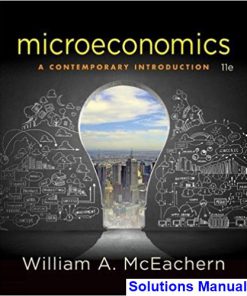Microeconomics A Contemporary Introduction 11th Edition McEachern Test Bank
$26.50$50.00 (-47%)
Microeconomics A Contemporary Introduction 11th Edition McEachern Test Bank.
You may also like
Microeconomics A Contemporary Introduction 11th Edition McEachern Test Bank

Product details:
- ISBN-10 : 1305505530
- ISBN-13 : 978-1305505537
- Author: Dr. William A. McEachern
Gain a strong understanding of microeconomic principles with hundreds of lively examples found in McEachern’s MICROECONOMICS: A CONTEMPORARY INTRODUCTION, 11E. This book draws on what you already have observed through your life experiences to help explain microeconomic concepts, choices, institutions, and events. Interesting printed and online case studies, the latest research findings, and focused examples offer genuine insight into how microeconomic principles work in today’s world. A friendly writing style is enhanced by learning features that make the material clear and more direct. Understandable graphs and exhibits include captions that summarize key points, color-coded curves, and helpful labels for clarification. More challenging graphs in the book are built one step at a time using new Progression Graphs software. Powerful learning tools, such as online Aplia and MindTap, further improve your understanding of microeconomics and its relevance to your success.
Table contents:
- Ch 1: The Art and Science of Economic Analysis
- Ch 1: Introduction
- 1.1: The Economic Problem: Scarce Resources, Unlimited Wants
- 1.2: The Art of Economic Analysis
- 1.3: The Science of Economic Analysis
- 1.4: Conclusion
- Ch 1: Summary
- Ch 1: Key Concepts
- Ch 1: Questions for Review
- Ch 1: Problems and Exercises
- Appendix: Understanding Graphs
- Ch 2: Economic Tools and Economic Systems
- Ch 2: Introduction
- 2.1: Choice and Opportunity Cost
- 2.2: Comparative Advantage, Specialization, and Exchange
- 2.3: The Economy’s Production Possibilities
- 2.4: Economic Systems
- 2.5: Conclusion
- Ch 2: Summary
- Ch 2: Key Concepts
- Ch 2: Questions for Review
- Ch 2: Problems and Exercises
- Ch 3: Economic Decision Makers
- Ch 3: Introduction
- 3.1: The Household
- 3.2: The Firm
- 3.3: The Government
- 3.4: The Rest of the World
- 3.5: Conclusion
- Ch 3: Summary
- Ch 3: Key Concepts
- Ch 3: Questions for Review
- Ch 3: Problems and Exercises
- Ch 4: Demand, Supply, and Markets
- Ch 4: Introduction
- 4.1: Demand
- 4.2: What Shifts a Demand Curve?
- 4.3: Supply
- 4.4: What Shifts a Supply Curve?
- 4.5: Demand and Supply Create a Market
- 4.6: Changes in Equilibrium Price and Quantity
- 4.7: Disequilibrium
- 4.8: Conclusion
- Ch 4: Summary
- Ch 4: Key Concepts
- Ch 4: Questions for Review
- Ch 4: Problems and Exercises
- Ch 5: Elasticity of Demand and Supply
- Ch 5: Introduction
- 5.1: Price Elasticity of Demand
- 5.2: Determinants of the Price Elasticity of Demand
- 5.3: Price Elasticity of Supply
- 5.4: Other Elasticity Measures
- 5.5: Conclusion
- Ch 5: Summary
- Ch 5: Key Concepts
- Ch 5: Questions for Review
- Ch 5: Problems and Exercises
- Appendix: Price Elasticity and Tax Incidence
- Ch 6: Consumer Choice and Demand
- Ch 6: Introduction
- 6.1: Utility Analysis
- 6.2: Measuring Utility
- 6.3: Applications of Utility Analysis
- 6.4: Conclusion
- Ch 6: Summary
- Ch 6: Key Concepts
- Ch 6: Questions for Review
- Ch 6: Problems and Exercises
- Appendix: Indifference Curves and Utility Maximization
- Ch 7: Production and Cost in the Firm
- Ch 7: Introduction
- 7.1: Cost and Profit
- 7.2: Production in the Short Run
- 7.3: Costs in the Short Run
- 7.4: Costs in the Long Run
- 7.5: Conclusion
- Ch 7: Summary
- Ch 7: Key Concepts
- Ch 7: Questions for Review
- Ch 7: Problems and Exercises
- Appendix: A Closer Look at Production and Cost
- Ch 8: Perfect Competition
- Ch 8: Introduction
- 8.1: An Introduction to Perfect Competition
- 8.2: Short-Run Profit Maximization
- 8.3: Short-Run Loss Minimization
- 8.4: Short-Run Supply Curves
- 8.5: Perfect Competition in the Long Run
- 8.6: Long-Run Industry Supply Curve
- 8.7: Perfect Competition and Efficiency
- 8.8: Conclusion
- Ch 8: Summary
- Ch 8: Key Concepts
- Ch 8: Questions for Review
- Ch 8: Problems and Exercises
- Ch 9: Monopoly
- Ch 9: Introduction
- 9.1: Barriers to Entry
- 9.2: Revenue for a Monopolist
- 9.3: Profit Maximization and Loss Minimization for a Monopolist
- 9.4: Perfect Competition and Monopoly Compared
- 9.5: Problems With Deadweight Loss Estimates
- 9.6: Price Discrimination
- 9.7: Conclusion
- Ch 9: Summary
- Ch 9: Key Concepts
- Ch 9: Questions for Review
- Ch 9: Problems and Exercises
- Ch 10: Monopolistic Competition and Oligopoly
- Ch 10: Introduction
- 10.1: Monopolistic Competition
- 10.2: Oligopoly
- 10.3: Three Approaches to Oligopoly
- 10.4: Comparison of Oligopoly and Perfect Competition
- 10.5: Conclusion
- Ch 10: Summary
- Ch 10: Key Concepts
- Ch 10: Questions for Review
- Ch 10: Problems and Exercises
- Ch 11: Resource Markets
- Ch 11: Introduction
- 11.1: The Once-Over
- 11.2: Demand and Supply of Resources
- 11.3: Temporary and Permanent Resource Price Differences
- 11.4: Opportunity Cost and Economic Rent
- 11.5: A Closer Look at Resource Demand
- 11.6: Conclusion
- Ch 11: Summary
- Ch 11: Key Concepts
- Ch 11: Questions for Review
- Ch 11: Problems and Exercises
- Ch 12: Labor Markets and Labor Unions
- Ch 12: Introduction
- 12.1: Labor Supply
- 12.2: Why Wages Differ
- 12.3: Unions and Collective Bargaining
- 12.4: Union Wages and Employment
- 12.5: Conclusion
- Ch 12: Summary
- Ch 12: Key Concepts
- Ch 12: Questions for Review
- Ch 12: Problems and Exercises
- Ch 13: Capital, Interest, Entrepreneurship, and Corporate Finance
- Ch 13: Introduction
- 13.1: The Role of Time in Production and Consumption
- 13.2: The Market for Loanable Funds
- 13.3: Why Interest Rates Differ
- 13.4: Present Value and Discounting
- 13.5: Entrepreneurship
- 13.6: Corporate Finance
- 13.7: Conclusion
- Ch 13: Summary
- Ch 13: Key Concepts
- Ch 13: Questions for Review
- Ch 13: Problems and Exercises
- Ch 14: Transaction Costs, Asymmetric Information, and Behavioral Economics
- Ch 14: Introduction
- 14.1: The Firm’s Rationale and Scope of Operation
- 14.2: Market Behavior With Imperfect Information
- 14.3: Asymmetric Information in Product Markets
- 14.4: Asymmetric Information in Labor Markets
- 14.5: Behavioral Economics
- 14.6: Conclusion
- Ch 14: Summary
- Ch 14: Key Concepts
- Ch 14: Questions for Review
- Ch 14: Problems and Exercises
- Ch 15: Economic Regulation and Antitrust Policy
- Ch 15: Introduction
- 15.1: Types of Government Regulation
- 15.2: Regulating a Natural Monopoly
- 15.3: Alternative Theories of Economic Regulation
- 15.4: Antitrust Law and Enforcement
- 15.5: Competitive Trends in the U.S. Economy
- 15.6: Conclusion
- Ch 15: Summary
- Ch 15: Key Concepts
- Ch 15: Questions for Review
- Ch 15: Problems and Exercises
- Ch 16: Public Goods and Public Choices
- Ch 16: Introduction
- 16.1: Public Goods
- 16.2: Public Choices in Representative Democracy
- 16.3: Exploiting Government Versus Avoiding Government
- 16.4: Bureaucracy and Representative Democracy
- 16.5: Conclusion
- Ch 16: Summary
- Ch 16: Key Concepts
- Ch 16: Questions for Review
- Ch 16: Problems and Exercises
- Ch 17: Externalities and the Environment
- Ch 17: Introduction
- 17.1: Negative Externalities and the Common-Pool Problem
- 17.2: Optimal Level of Pollution
- 17.3: Environmental Protection
- 17.4: Positive Externalities
- 17.5: Conclusion
- Ch 17: Summary
- Ch 17: Key Concepts
- Ch 17: Questions for Review
- Ch 17: Problems and Exercises
- Ch 18: Poverty and Redistribution
- Ch 18: Introduction
- 18.1: The Distribution of Household Income
- 18.2: Redistribution Programs
- 18.3: Who Are the Poor?
- 18.4: Some Unintended Consequences of Income Assistance
- 18.5: Welfare Reforms
- 18.6: Conclusion
- Ch 18: Summary
- Ch 18: Key Concepts
- Ch 18: Questions for Review
- Ch 19: International Trade
- Ch 19: Introduction
- 19.1: The Gains From Trade
- 19.2: Trade Restrictions and Welfare Loss
- 19.3: Efforts to Reduce Trade Barriers
- 19.4: Arguments for Trade Restrictions
- 19.5: Conclusion
- Ch 19: Summary
- Ch 19: Key Concepts
- Ch 19: Questions for Review
- Ch 19: Problems and Exercises
- Ch 20: International Finance
- Ch 20: Introduction
- 20.1: Balance of Payments
- 20.2: Foreign Exchange Rates and Markets
- 20.3: Other Factors Influencing Foreign Exchange Markets
- 20.4: International Monetary System
- 20.5: Conclusion
- Ch 20: Summary
- Ch 20: Key Concepts
- Ch 20: Questions for Review
- Ch 20: Problems and Exercises
- Ch 21: Economic Development
- Ch 21: Introduction
- 21.1: Worlds Apart
- 21.2: Productivity: Key to Development
- 21.3: International Trade and Development
- 21.4: Foreign Aid and Economic Development
- 21.5: Conclusion
- Ch 21: Summary
- Ch 21: Key Concepts
- Ch 21: Questions for Review
- Ch 21: Problems and Exercises
- Glossary
- Index
People also search:
Microeconomics A Contemporary Introduction 11th
Microeconomics A Contemporary Introduction 11th pdf
Microeconomics A Contemporary Introduction 11th pdf free
Microeconomics A Contemporary Introduction 11th download scribd
Microeconomics A Contemporary Introduction 11th pdf free download












